G. Wayne Miller's Blog, page 2
October 31, 2024
Halloween and a major book anniversary
Thirty-five years ago thisautumn, just in time for Halloween, my first book, the horror novel ThunderRise, was published. I was represented by the late Kay McCauley and herbrother, the late Kirby McCauley, who at the time were the agents for StephenKing, whose work has greatly influenced my fiction.
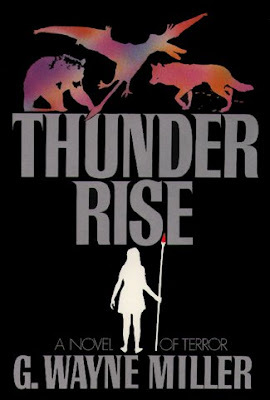
Needless to say, publication was exciting. Thunder Riselaunched my book-writing career – 21 fiction and non-fiction books as of thiswriting. Two are the second and third volumes in the Thunder Risetrilogy: Asylum and Summer Place. Several others are also horrornovels.
Following the U.S. hardcoverpublication of Thunder Rise in 1989, a British edition was published andalso a U.S. paperback. Thunder Rise today is available in audio andKindle from Crossroad Press.
I met Kay McCauley at the 1986World Fantasy Convention, held in Providence at the then-Biltmore Hotel.The inaugural World Fantasy Convention, in 1975, was chaired by Kay’s brotherand it, too, took place in Providence, where Lovecraft and Poe lived.
When someone pointed out Kay to me,I introduced myself. I wanted to interview King for a story in The ProvidenceJournal, where I was a staff writer, and thinking King would respond favorablyto a “kindred spirit,” I told Kay I wrote horror, too (short stories in TheHorror Show, Alfred Hitchcock's Mystery Magazine, and other magazines). Kaynever was able to arrange the interview, but she liked my short stories andasked if I had written any books. I had and she sold Thunder Rise toWilliam Morrow, now a division of HarperCollins.
In the following years, Kay, wholived in New York City, became my dear friend and she representedme for several more books before semi-retiring (her only client in her finaldays was George R.R. Martin, of Game of Thrones fame). She died in 2020,RIP Kay. Kirby had died in 2014.
 This photo of Kay is from Martin's tribute to her.
This photo of Kay is from Martin's tribute to her.So on thisHalloween, my thoughts turn to the past, and not just books but also the manyyears of trick-or-treating with my children and grandchildren.

My thoughtsturn, too, to the present.
HappyHalloween, all!
About Thunder Rise, from theoriginal-edition jacket:
Relentlessly gripping, this debutnovel is classically responsive to the adage that fictional horror is far morevivid in daylit, familiar surroundings than in darkly dripping gothic vistas.Morgantown, an old, white clapboard and steepled town in the lovely Berkshiresof western Massachusetts: America could have few settings as idyllic andinviting -- or as deadly. Up against the towering mass of Thunder Rise, themountain behind which the sun sets every evening, Morgantown is cowering --from a nameless, lethal and seemingly sourceless malady that threatens thepopulace through its most vulnerable members, the children.
Journalist Brad Gale, who has fled abroken marriage and given up a top New York job, has come to Morgantown seekera serener life as editor of the local Daily Transcript. With him he bringsfive-year-old Abbie, "Apple Guy" of his eye. When the mysteriousaffliction strikes Morgantown's youngest inhabitants, signaled bysoul-shattering nightmares of individual creatures of dread -- a bear, a wolf,a prehistoric carnivore -- and followed by an inexplicable wasting away, Bradknows it is a story to be explored in full. Then Abbie is stricken and Brad toomust join in deadly battle with a force beyond rational imagining.
As more children sicken and slidetoward doom, the struggles of the medical establishment seem increasinglyfutile. Even a trained and scoffing skeptic like Brad becomes reluctantly andbelatedly drawn to listen to the beliefs and theories of Charlie Moonlight, aQuidneck Native American who speaks of the primordial demon lurking in theheart of Thunder Rise now stirring anew. At the end a battle of terror is drawn-- with the reader enlisted in as close and fateful combat as the printed pagecan ever afford.
“An Unbroken Pact,” one of myearliest horror stories, written for my high school newspaper:

October 14, 2024
Wolf Hill
Wolf Hill: An essay from long ago.
I periodically repostsome of my favorite essays. Here's one, set in autumn, my favorite season. Iwrote this in October 1997, on a break from finishing my fourth book, Toy Wars:The Epic Struggle Between G.I. Joe, Barbie and the Companies That Make Them.Cal is an adult today, living in Rhode Island after five years in Japan. Racheland Katy have children of their own. Life, like a river, keeps on flowing.
WOLF HILL
An Essay About a Boy
We avoid the woods in summer. We don't like bugs, the ticksand mosquitoes especially, and anyway, we're drawn to the beach at Wallum Lake,which is just up the road. But early October finds us eager for the firstkilling frost. It came this year at the customary time, when the sugar maplesare at their peak and the oaks are only beginning to turn. The temperature atdawn read 29 or 30 degrees, depending on the angle the thermometer was viewed.I figured if any of my city friends asked, I'd say 29.
By late afternoon, it had warmed to almost 50. The sky wascloudless and the breeze had shifted to the south. I put on my boots and vestand helped Cal, who is almost three, on with his. Our vests have large pockets,very important for walks in the woods. We went through the backyard and ontothe cart path that ascends Wolf Hill, a fanciful name in the nineties, even fora rural town like ours. Cal's first priority was equipping himself with astick. He found one about two feet long, and another slightly larger, which hegave me. ``Little boys need big sticks,'' he observed. I wholeheartedly agreed.
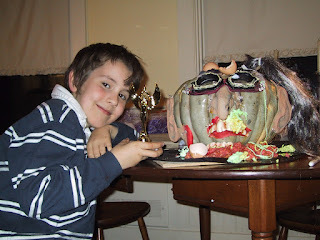
Many years ago, when a farmhouse graced the top of WolfHill, the path could accommodate vehicles; one, a bus, ended its last journeyup there and its rotting remains continue to be a source of wonderment to allwho happen upon it. Every year the mountain laurel and pine claim more of thepath, and this year was no exception, but there was still plenty of room --more than sufficient, I informed Cal, for another good flying- saucer run thiswinter. Cal insisted on taking the lead and, unlike our last walk, in April, herefused assistance getting past deadfalls. He went under, or around, and thenstopped to reveal the appropriate route to me. ``Dad, come on over here,'' hesaid at one point, ``that's a safe place to get by.''
We climbed, past the inevitable stone walls, stillremarkably intact, if mostly overgrown. The air seemed fresher as we continued,the light through the foliage stronger, and soon enough we'd reached the peak.Only a cellar hole is left of the farmhouse, destroyed some thirty years ago ina fire of suspicious origin. Rusting machinery, barrels and bedframes arestrewn about, and the woods are slowly claiming them, too. We marveled togetherat a sight as strange as grape vines entwined around a bedframe, and I triedexplaining how a house not unlike our own had been reduced to ruin, but I don'tbelieve I succeeded, nor did I really try. I steered Cal's attention to theonly grass on Wolf Hill, a small, sunlit remnant of lawn. We pickedwildflowers, the last of the season. I did not know the species. They hadthirteen petals and came in two shades: lavendar and white. The frost had nottouched them. Cal was more interested in mushrooms. He'd been keen on mushroomssince our last swim at Wallum Lake, when he found ones as big as my hand thathad materialized overnight beneath a picnic bench. He also gathered acorns,which he proposed to feed to squirrels, a word he still had difficultypronouncing.
From the cellar hole, we descended to the quarry. Icautioned Cal not to run, but he explained that he was not -- this wasskipping. I wanted to carry him or at least hold his hand; instead, I took abreath and was silent on the matter. The quarry has not been worked since the1800s, but if you look around town, you will see many foundations made of itsimperfect granite. Our own front steps, I am sure, came from here. Water haslong filled where men once labored, of course, and a century's worth of sedimentcovers the bottom, making it impossible to gauge true depth (although we havetried, with our sticks). When Cal is a little older, I will tell him -- as Idid his sisters -- spooky stories of the goings-on here when the moon is full.For now, we concern ourselves with water. It had not rained in over a week, andthe stream that empties the quarry was dry. Our April walk was during anor'easter, and we got soaked playing in the waterfall, but it was gone now,too. Cal was worried it would never return, but I reassured him it would, withthe next steady downpour.
The shadows were lengthening and the temperature was edgingdown. An inventory of our pockets disclosed sticks, pebbles, acorns, flowers,mushrooms and a bright yellow leaf, which Cal had selected for his mom. We leftthe quarry and made our way back to the cart path through a stand of toweringBalsam firs, unlike any other on Wolf Hill. When the girls were small, longbefore Cal was born, we found this place. It resembles a den, and the forestfloor is softly carpeted and often dotted with toadstools -- certainly a spot,I allowed, where elves dance under the starry sky. Honest? Rachel and Katy werewide-eyed. There was only one way to know for sure, I said: Some fine summernight, we would have to camp out here, being careful to stay awake untilmidnight. We never did. Rachel is in high school now, and Katy, four yearsyounger, is sneaking looks at Seventeen. Cal listened with great interest atthe prospect of seeing elves. He was tired, and as I carried him home, Ipromised we'd camp out next summer, bugs and all. I intend to ask Rachel andKaty if they'd care to join us.
Copyright © 1997 G. Wayne Miller
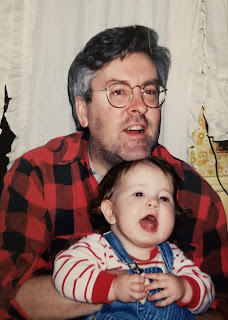
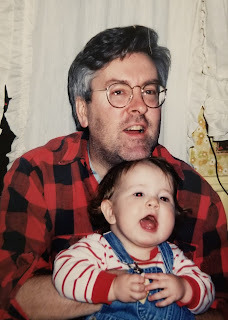
October 11, 2024
Looking back: Vox interview about Car Crazy by senior producer Phil Edwards
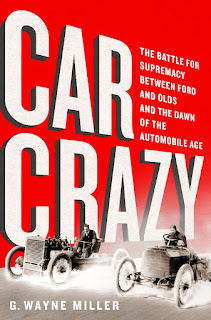
We all know the horseless carriage beat out the horse — but the early battles were surprisingly fierce and involved some nasty PR tactics. And as the above video shows, this marketing conflict from the early 1900s may show how a battle between self-driving cars and traditional cars could play out.
That story is one of the highlights in G. Wayne Miller’s Car Crazy: The Battle for Supremacy Between Ford and Olds and the Dawn of the Automobile Age. Miller told me that early carmakers adopted a variety of marketing techniques to sell cars that weren’t particularly cheap or reliable. That arsenal often fired shots against the horse.
And despite the car’s shortcomings, the horse really did create a lot of problems that automobiles could fix. Horse manure was a serious public health hazard; thousands of horses were maltreated (and as many died); and, of course, horses had less acceleration and braking power than the car, resulting in slowdowns and accidents.
As we look ahead to a public conversation about the merits of self-driving cars over traditionally driven ones, the horse and car battle may prove to be prescient. New technologies aren’t easily accepted — and sometimes even a superior product has to adopt fierce tactics to win.
September 7, 2024
New five-star review for "Unfit to Print: A Modern Media Satire"
Five-star review for Unfit to Print: A Modern MediaSatire
Reviewed by Christian Sia for Readers’ Favorite
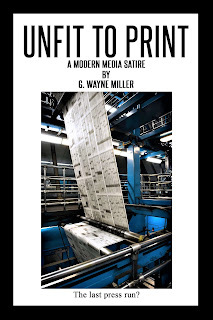
Unfit to Print: A Modern Media Satire by G. WayneMiller delivers a visceral critique of modern journalism. Nick Nolan, a formerPulitzer Prize-nominated journalist, fights to redeem his career whenSuperGoodMedia buys the venerable Boston Daily Tribune. He has a few monthsleft on the paper. But everything changes when he writes a column about an8-year-old called Amber Abbott. Her mother and Nolan’s former lover claim theVirgin Mother speaks to her. His column becomes a viral sensation, and he'sthrust into the spotlight. As he becomes increasingly obsessed with the clicksand attention his story generates, he's aided by an unexpected guest — noneother than Benjamin Franklin — who offers his guidance and wisdom. However, asNick's fortunes rise, so do the stakes, and he must confront the darker side ofjournalism and the corporate interests that are destroying the industry.
With its sharp critique, this novel is a timely and urgentwarning about the future of truth-telling in the media. G. Wayne Miller's Unfitto Print is a powerful commentary on the decline of local journalism and itsimpact on democracy. There is a struggle to maintain the integrity and qualityof local journalism in the face of declining readership and increasingcompetition from online media sources. There is a conflict between the oldguard of journalism, represented by Nick and his colleagues, and the latestwave of online media entrepreneurs who are more interested in clicks andprofits than serious reporting. Characterization is impeccable, and Nolan is anuanced, genuinely flawed protagonist who catches readers' attention the momentthey encounter him in the story. Destiny Carter, the African American businessreporter at the Tribune, is another sophisticated character whose sharp wit andinsight provide a much-needed perspective on the industry's challenges. Theauthor explores themes such as the importance of local journalism, the impactof social media on democracy, and the need for quality reporting in a worldwhere "fake news" and "alternative facts" are increasinglyprevalent. This is an ingeniously plotted and cleverly written novel.

July 13, 2024
Listen to Joe Biden in 2009, after he became vice president.
I interviewed Joe Biden by telephone in 2009 for An Uncommon Man: The Life and Times of Senator Claiborne Pell, the biography I was writing that was published in 2011.
Biden was 66 years old.
How much has changed since then.

Listen to the interview (takes a moment to load):
July 4, 2024
COVID theme songs? My pick: Duran Duran's Ordinary World.
Originally published in The Providence Journal on July 12, 2021.
COVID-19 theme songs?Many fit as the pandemic changed since earliest days.
The Providence Journal

As The Journal’s health-care reporter, I have been coveringCOVID-19 since January 2020. Earlyon, I began to wonder:
If thecoronavirus pandemic had a theme song, what would it be?
Mychoices changed as the months passed and Rhode Island and the world experiencedsurges, emergency orders, and a devastating toll in lives and jobs lost.
Morerecently, of course, Rhode Island’s high vaccination rate has helped us to asummer much better than last year's. There are reasons to believe again inordinariness, and with that in mind, let me share my evolving nominations fortheme songs, starting in March 2020, when I wrote my first #coronavirusReporter’s Notebook, “Thoughts on living in a state ofdystopia.”
In it,I referenced Stephen King, my favorite fiction author, and his 1978post-apocalyptic novel “The Stand,” about a global pandemic. It became apopular TV mini-series in 1994, with songs including Barry McGuire’s cover of“Eve of Destruction.” King himself played guitar for the mini-series renditionof the song.
“Eveof Destruction” is my pick for the early-pandemic theme song. The Barry McGuirecover was released in 1965, during the Cold War and the debacleof Vietnam, but its sentiment captured the mood of late winter 2020.
Can'tyou feel the fear that I'm feeling today?
If thebutton is pushed, there's no running away
There'llbe no one to save with the world in a grave
Take alook around you boy, it's bound to scare you, boy
By theend of spring 2020, more than 16,000 positive cases of coronavirus disease hadbeen reported in Rhode Island (more than 2 million in the U.S.). The death toll in Rhode Islandsurpassed 850. Restrictions prevented relatives and friendsfrom visiting loved ones who were dying in hospitals, and wakes and funeralswere severely curtailed.
JamesTaylor’s “Fire and Rain” fits for a theme song then, with its haunting melodyand lyrics, including these:
I'veseen fire and I've seen rain
I'veseen sunny days that I thought would never end
I'veseen lonely times when I could not find a friend
But Ialways thought that I'd see you again
Thegloom deepened when, in late July 2020, deaths surpassed 1,000.
LanaDel Rey’s “Summertime Sadness” was on my mind then — and during August andSeptember. The song is the story of two deaths by suicide, but the lyrics speakmore broadly to loss in general. They also, to me at least, capture the mental-health crises thatso many have experienced, a topic I have frequently explored inmy reporting.
ThinkI'll miss you forever
Likethe stars miss the sun in the morning sky
Earlyautumn 2020 brought hopeful developments, including the reopening of someschools, but public-health experts were warning of a possible new surge ahead(they were right). COVID continued to cause unprecedented economicsuffering for many. Green Day’s “Wake Me Up When September Ends” gets my nodfor this period of the pandemic.
Herecomes the rain again
Fallingfrom the stars
Drenchedin my pain again
As thelast month of 2020 began, vaccines were not yet available. Another terribleholiday season seemed on the horizon (it was). What better song for December2020 than B.B. King’s “Everyday I Have the Blues”?
Everyday,
I havethe blues
Ooheveryday,
Everyday,
I havethe blues
Thefirst shots of the Pfizer vaccine were administered in Rhode Island on Dec. 14,to Lifespan front-line workers. The next day, Care New Englandemployees rolled up their sleeves. Can’t find a better song forexpectations than Carrie Underwood’s “Hallelujah,” as she performed itwith Legend.
Letthe lonely join together, let them know their worth
Ooh,let the children know
There'sa brighter day ahead (let's hold on to hope)
Aslast winter ended and spring 2021 arrived, the data trends in Rhode Islandturned positive. Could there be a better song for the second quarter of thisyear than Jimmy Cliff’s “I Can See Clearly Now?”
I cansee clearly now the rain is gone
I cansee all obstacles in my way
Hereis that rainbow I've been praying for
It'sgonna be a bright (bright)
Bright(bright) sunshiny day
Whichbrings me to my pick for overall theme song.
First,a disclaimer: popular though they were, the band that wrote and recorded thissong was not one of my favorites when they broke onto the music scene. Butwhen Duran Duran released “Ordinary World” a few years later in 1993, I wasenthralled. During the pandemic, I have listened to it again (and again) andthe lyrics (and incomparable melody) have become an earworm.
Noroom to include them all, but consider these in judging whether “OrdinaryWorld” best captures the sadness and hopes of the last year and a half:
Whereis the life that I recognize?
Goneaway
But Iwon't cry for yesterday
There'san ordinary world
SomehowI have to find
And asI try to make my way
To theordinary world
I willlearn to survive
Perhapscoincidentally (or not), Duran Duran was featured last weekon Today. The Brits performed a new song and announced theirintention to tour again next year.
In themusic world, at least, that indeed would be an ordinary world.
Iinvite you to send your nominations for pandemic theme songs, along with abrief explanation of why. I may use them in a future #coronavirus Reporter'sNotebook. Send to gwmiller@providencejournal.com,writing “COVID song” in the subject field.
April 6, 2024
Final revisions of "Life Happened," my latest screenplay, complete.
LIFE HAPPENEDby G. WAYNE MILLER
Copyright 2023gwaynemiller.com
WGA registryno. 2222611
LOGLINE
During a momentous historical period – the late 1970s andearly 1980s – that is eerily reminiscent of today, politics, love, drugs, murder,mystery, music, racism, mental illness and sex collide at the fictional TheDaily Times, where the Pulitzer Prize-winning staff seeks to tell truths,right wrongs, and help keep democracy alive. http://www.gwaynemiller.com/extendedbio.htm#film

December 28, 2023
Burnt Cove
The novel Burnt Cove will be my 22nd published book when it is released in 2025.
First draft finished on August 25, 2024. Hard-copy editing completed on September 8, 2024. Additional editing in progress as of October 6, 2024.
For a chance to win an autographed copy and more, emailpascoagwriter@gmail.com and write "Burnt Cove" in the subject field.

This is the opening:
Copyright 2024 gwaynemiller.com
(This post was last updated on October 6, 2024)

“Deathleaves a heartache no one can heal. Love leaves a memory no one can steal.” –Irish headstone
A passerby traveling the road that descendsinto the village of Stonington on Deer Isle, Maine, at eleven o’clock onthat cloudless morning of Thursday, June 15, would have observed a scene thatcould have been described as peaceful and pretty.
Framed by a white chapel to the left and theharbor with the emerald stepping-stone islands of Merchant Row beyond to theright, a cemetery with its carefully trimmed grass and abundance of weatheredtombstones presented itself as picturesque in that quintessential coastal NewEngland way. The oaks and maples shimmered with fresh young leaves in a springthat last week had turned unseasonably warm, a delightful development, allagreed, after a winter that had continued stubbornly past Easter, when fourinches of snow fell, ruining the egg hunt and sunrise services. Only theirregular mound of back-hoed earth beneath a green tarp would have broughtunpleasantness into the passerby’s mind.
A new grave had been dug.
And there, next to it in a coffin, was a woman aboutto assume permanent residence.
Measured numerically, the living who had joinedthe deceased in her final moments above ground constituted an unimpressiveassembly.
These were them: Fr. Bertrand Lombardi, the octogenarianpastor of Saint Andrew Church,home of the island’s only Roman Catholic parish; three part-time employees, thefull staff, of Farrington Family Funeral Home; and 16 mourners, all but one middle-agedor older. The oldest was a wheelchair-bound man who was in the care of an aideand encased in an Afghan, despite the humidity and heat, 76 degrees and climbing.
And thus a passerby might have assumed that the dearlydeparted had been a person of no particular import, in the larger sense: alocal who had passed a quiet existence, troubling no one outwardly and likelyhaving made a meritorious contribution to the gene pool; and/or a native-bornreturned after decades from a more tax- and climate-friendly place (Florida, ifone had to guess). The sort of ordinary person who had been the subject ofordinary obituaries with an outdated head shot in the regional weeklies, TheEllsworth American and Island Ad-Vantages -- obituaries laced with“dearly” and “beloved” and “loving” and other such flowery adjectives composedby a funeral-home director with tearful input from a family member with nodesire for candor, let alone full disclosure, at this Most Difficult Time.
And that assumption would have been correct.
The deceased’s obituary, illustrated with ablack-and-white photo some three decades old, had indeed appeared in thisweek’s editions of The Ellsworth American and Island Ad-Vantages.Beyond the canned tributes, it offered little more than an age, a birthplace,names of relatives and a request that in lieu of flowers, donations in her namebe made to ,Burnt Cove, Deer Isle, ME, 04627.
In her 97 years, more than she had expected ordesired, the existence of Rose O’Reilly White had been confirmed in publishedform only four times before.
The first marked her wedding to her husband Bill,the man in the wheelchair, on August 23, 1947, in a Charlestown, Massachusetts,church: a two-paragraph story without photo that ran in the Boston DailyAdvertiser together with a dozen similar accounts of the latest post-warcouples who had committed to their role in bringing forth the initially promisingbut (given how the country and the planet had worsened on its watch) ultimatelydisappointing Baby Boom, which was beginning to depart the scene with a fetidstew of political buffoonery, xenophobia, homophobia, misogyny, racism, MAGAmayhem, and incessant whining about depleted 401(k) accounts and the cost ofMedicare Plan B, leaving replacement generations whose digital obsessions(think: TikTok) were turning human behavior robotic; not good, no matter howyou dissected it. And Artificial Intelligence would finally sink the shipaltogether, the doomsayers predicted. Granted, there were many Boomers who gaveback and whined not, and many who struggled for their food, housing andhealthcare in civilization’s richest nation ever, shame on America and itspoliticians. But would history tell their stories?
The second published confirmation of Rose’sexistence was a story in the Bangor Daily News in July 1965commemorating the tenth anniversary of Paradise Park, a small theme park notedfor its mini-golf, batting cage, petting zoo, Tilt-A-Whirl and 50-cent lobsterrolls that Rose and Bill had opened and owned: Ten Fun Years at Deer Isle’s‘Family Destination,’ the headline read. At the time this cheeryrepresentation of Paradise Park had been published, Rose was five monthspregnant with Jack, her only son, the middle-aged man who stood today at hergraveside.
Her third previous published appearance concernedsomething tragic: her inclusion in the obituary of her and Bill’s daughter, whooccupied the grave next to that into which she herself was about to be lowered:BRENDA O’REILLY WHITE, February 1, 1950 - July 29, 1973, With the AngelsNow, the small granite stone read.
And her fourth had been in the autumn of 1982,when Paradise Park had burned to the ground, never to reopen. That had drawnmedia attention including a report on Portland’s MCSH TV’s six o’clock newsbroadcast and accounts in local newspapers, large and small, around the state.“Paradise Lost,” was the headline in the Kennebec Journal, as Rose couldhave shown a visitor in the scrapbook she kept.
But how little media stories and obits tell aboutthe lives the dead actually lived.
How many secrets are taken to the grave, or thecrematory, depending on your final wish.
Rose took many of her own with her, but unlikemost others, she’d left a key to unlock them.
More secrets than any of those assembled todaycould have imagined.
Any, that is, but Bill.
The Bill, that is, who once inhabited the body ofthe old man in the wheelchair.
Which was precisely what Rose had intended when,during Jack’s last visit, she had handed him the key to a safe deposit box at BarHarbor Bank & Trust with his promise not to open it until the time wasright.
“When will that be?” Jack had said.
“You will know,” Rose had said.
Now I do, Jack thought as he stood there thatmorning of Thursday, June 15, 2023.
Burnt Cove: Mystery, Murder, and a Haunting in Maine
The novel Burnt Cove: Mystery, Murder, and a Haunting in Maine will be my 22nd published book when it is released in 2025.
This is the opening.
Copyright 2024 gwaynemiller.com
(This post was last updated on July 31, 2024)

“Deathleaves a heartache no one can heal. Love leaves a memory no one can steal.” –Irish headstone
A passerby traveling the road that descendsinto the village of Stonington on Deer Isle, Maine, at eleven o’clock onthat cloudless morning of Thursday, June 15, would have observed a scene thatcould have been described as peaceful and pretty.
Framed by a white chapel to the left and theharbor with the emerald stepping-stone islands of Merchant Row beyond to theright, a cemetery with its carefully trimmed grass and abundance of weatheredtombstones presented itself as picturesque in that quintessential coastal NewEngland way. The oaks and maples shimmered with fresh young leaves in a springthat last week had turned unseasonably warm, a delightful development, allagreed, after a winter that had continued stubbornly past Easter, when fourinches of snow fell, ruining the egg hunt and sunrise services. Only theirregular mound of back-hoed earth beneath a green tarp would have broughtunpleasantness into the passerby’s mind.
A new grave had been dug.
And there, next to it in a coffin, was a woman aboutto assume permanent residence.
Measured numerically, the living who had joinedthe deceased in her final moments above ground constituted an unimpressiveassembly.
These were them: Fr. Bertrand Lombardi, the octogenarianpastor of Church ,home of the island’s only Roman Catholic parish; three part-time employees, thefull staff, of Home;and 16 mourners, all but one middle-aged or older. The oldest was awheelchair-bound man who was in the care of an aide and encased in an Afghan,despite the humidity and heat, 76 degrees and climbing.
And thus a passerby might have assumed that the dearlydeparted had been a person of no particular import, in the larger sense: alocal who had passed a quiet existence, troubling no one outwardly and likelyhaving made a meritorious contribution to the gene pool; and/or a native-bornreturned after decades from a more tax- and climate-friendly place (Florida, ifone had to guess). The sort of ordinary person who had been the subject ofordinary obituaries with an outdated head shot in the regional weeklies, TheEllsworth American and Island Ad-Vantages -- obituaries laced with“dearly” and “beloved” and “loving” and other such flowery adjectives composedby a funeral-home director with tearful input from a family member with nodesire for candor, let alone full disclosure, at this Most Difficult Time.
And that assumption would have been correct.
The deceased’s obituary, illustrated with ablack-and-white photo some three decades old, had indeed appeared in thisweek’s editions of The Ellsworth American and Island Ad-Vantages.Beyond the canned tributes, it offered little more than an age, a birthplace,names of relatives, and a request that in lieu offlowers, donations in her name be made to , Burnt Cove, Deer Isle, ME, 04627.
In her 97 years, more than she had expected or towardthe end desired, the existence of Rose O’Reilly White had been confirmed inpublished form only four times before.
The first marked her wedding to her husband Bill,the man in the wheelchair, on August 23, 1947, in a Charlestown, Massachusetts,church: a two-paragraph story without photo that ran in the Boston DailyAdvertiser together with a dozen similar accounts of the latest post-warcouples who had committed to their role in bringing forth the initially promisingbut (given how the country and the planet had worsened on its watch) ultimatelydisappointing Baby Boom, which was beginning to depart the scene with a fetidstew of political buffoonery, xenophobia, misogyny, homophobia, racism, MAGAmayhem, and incessant whining about depleted 401(k) accounts and the cost ofMedicare Plan B, leaving replacement generations whose digital obsessions(think: TikTok) were turning human behavior robotic; not good, no matter howyou dissected it. And Artificial Intelligence would finally sink the shipaltogether, the doomsayers predicted.
The second published confirmation of Rose’sexistence was a story in the Bangor Daily News in July 1965commemorating the tenth anniversary of Paradise Park, a small theme park notedfor its mini-golf, batting cage, petting zoo, Tilt-A-Whirl and 50-cent lobsterrolls that Rose and Bill had opened and owned: Ten Fun Years at Deer Isle’s‘Family Destination,’ the headline read. At the time this cheeryrepresentation of Paradise Park had been published, Rose was five monthspregnant with Jack, her only son, the middle-aged man who stood today at hergraveside.
Her third previous published appearance concerned something tragic: her inclusion inthe obituary of her and Bill’s daughter, who occupied the grave next to thatinto which she herself was about to be lowered: BRENDA O’REILLY WHITE,February 1, 1950 - July 29, 1973, With the Angels Now, the smallgranite stone read.
And her fourth had been in the autumn of 1982,when Paradise Park had burned to the ground, never to reopen. That had drawnmedia attention that included a report on Portland’s MCSH TV’s six o’clock newsbroadcast and accounts in local newspapers, large and small, around the state.“Paradise Lost,” was the headline in the Kennebec Journal, as Rose mighthave shown a visitor in the scrapbook she kept.
But how little media stories and obits tell aboutthe lives the dead actually lived.
How many secrets are taken to the grave, or thecrematory, depending on your final wish.
Rose took many of her own with her, but unlikemost others, she’d left a key to unlock them.
More secrets than any of those assembled todaycould have imagined.
Any, that is, but Bill.
The Bill, that is, who once inhabited the body ofthe old man in the wheelchair.
Which was precisely what Rose had intended when,during Jack’s last visit, she had handed him the key to a safe deposit box at BarHarbor Bank & Trust with his promise not to open it until the time wasright.
“When will that be?” Jack had said.
“You will know,” Rose had said.
Now I do, Jack thought as he stood there thatmorning of Thursday, June 15, 2023.
"Burnt Cove: Mystery, Murder, and a Haunting in Maine"
The novel "Burnt Cove: Mystery, Murder, and a Haunting in Maine" will be my 22nd published book when it is finished sometime in the year 2025.
This is the opening.

Chapter 1
“Death leaves a heartache no one can heal.Love leaves a memory no one can steal.” – Irish headstone
A passerby traveling the road that descends intothe village of Stonington on Deer Isle, Maine, at eleven o’clock on thatcloudless morning of Thursday, June 15, would have observed a scene that couldhave been described as peaceful and pretty.
Framed by a white chapel to the left and theharbor with the emerald stepping-stone islands of Merchant Row beyond to theright, a cemetery with its carefully trimmed grass and abundance of weatheredtombstones presented itself as picturesque in that quintessential coastal NewEngland way. The oaks and maples shimmered with fresh young leaves in a springthat last week had turned unseasonably warm, a delightful development, allagreed, after a winter that had continued stubbornly past Easter, when fourinches of snow fell, ruining the egg hunt and sunrise services. Only theirregular mound of back-hoed earth beneath a green tarp would have broughtunpleasantness into the passerby’s mind.
A new grave had been dug.
And there, next to it in a coffin, was a woman aboutto assume permanent residence.
Measured numerically, the living who had joinedthe deceased in her final moments above ground constituted an unimpressiveassembly.
These were them: Fr. Bertrand Lombardi, the octogenarianpastor of Church,home of the island’s only Roman Catholic parish; three part-time employees, thefull staff, of Home;and 16 mourners, all but one middle-aged or older. The oldest was awheelchair-bound man who was in the care of an aide and encased in an Afghan,despite the humidity and heat, 76 degrees and climbing.
And thus a passerby might have assumed that the dearlydeparted had been a person of no particular import, in the larger sense: alocal who had passed a quiet existence, troubling no one outwardly and likelyhaving made a meritorious contribution to the gene pool; and/or a native-bornreturned after decades from a more tax- and climate-friendly place (Florida, ifone had to guess). The sort of ordinary person who had been the subject ofordinary obituaries with an outdated head shot in the regional weeklies, TheEllsworth American and Island Ad-Vantages -- obituaries laced with“dearly” and “beloved” and “loving” and other such flowery adjectives composedby a funeral-home director with tearful input from a family member with nodesire for candor, let alone full disclosure, at this Most Difficult Time.
And that assumption would have been correct.
The deceased’s obituary, illustrated with ablack-and-white photo some three decades old, had indeed appeared in thisweek’s editions of The Ellsworth American and Island Ad-Vantages.Beyond the canned tributes, it offered little more than an age, a birthplace,names of relatives, and a request that in lieu offlowers, donations in her name be made to Haven Home Nursing and RehabilitationCenter, Burnt Cove, Deer Isle, ME, 04627.
In her 97 years, more than she had expected or towardthe end desired, the existence of Rose O’Reilly White had been confirmed inpublished form only four times before.



